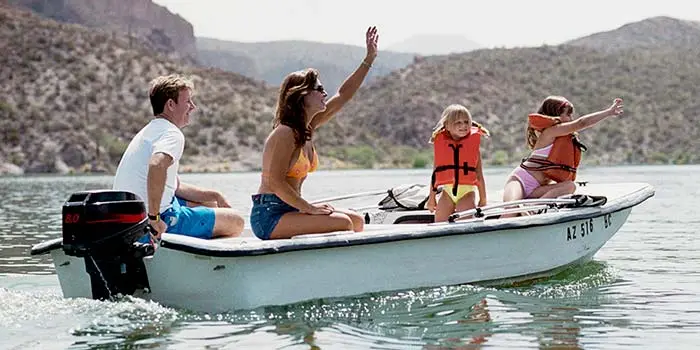How to Get Your Boat Ready for Summer


The temperature grows a little warmer and the days get a little longer. Summer’s on the horizon, and you know it won’t be long until you’re back to boating. Before you hit the water, get your boat and boating equipment ready with this step-by-step checklist. Print it out, stick it in a plastic bag and keep it onboard. And don’t forget to review our summer boating safety tips with boating newbies or guests on the lake.
De-winterize Your Boat
There are two ways to store your boat for the winter: haul it out of the water and keep it safe in a dry storage barn or garage, or take it to the nearest marina that prepares it for winter and stores it for you. If your boat is at a marina, you likely won’t need to go through the de-winterizing boat checklist, as marinas typically take care of these items before lowering boats into the water for the season. However, if you’re the sole caretaker, follow these steps to get your boat ready for summer.
Step 1: Check Boating Equipment
While your boat sits out of water, go through these items to ensure everything is in working condition.
Step 2: Inspect your Boat for Leaks
Take advantage of your boat being out of the water. Examine its exterior for any blisters or cracks. Use a flashlight to check for any fluid leaks under the engine.
Step 3: Wash and Wax the Boat
Before your first excursion, give your boat a good wash to remove any water spots and dried mineral deposits. You may want to apply a new layer of bottom paint, too. To finish it off, a few coats of wax will keep your boat shiny and protected from UV rays.
Step 4: Update all Necessary Documents
Like your car, every year you’ll need to update your registration decal and proof of insurance. You can always check in with your Farm Bureau Agent to make sure your boat is properly insured and ready to hit the water this summer. Have the registration number or certificate on board at all times, whether you’re in your home state or traveling.
Summer Boating Safety Tips
Now that your boat has undergone a rigorous pre-summer condition check, it’s ready to be lowered into the water. But smart boaters know the preparation doesn’t stop there. Take control of your safety and follow this pre-departure boat safety checklist.
Sink or Swim: Test Your Knowledge with our Boating Safety Quiz
Load Up the Life Jackets
You’ll need a U.S. Coast Guard-approved Type I, II, III or V life jacket of suitable size for each person on the boat, plus one Type IV (the throwable devices) on board at all times. In most states, children under 13 years old are required by law to wear a USCG-approved life jacket unless they are below deck or in an enclosed cabin.
Keep Other Necessary Boating Safety Equipment on Hand
The U.S. Coast Guard’s list of required boating safety equipment includes, but isn’t limited to, oars, bailing bucket, whistle or bell, a readily accessible fire extinguisher, flares and anchor.
Examine the Navigation Lights
Your white all-around light should be visible for 2 miles. The green starboard and red portside lights must be visible from 1 mile away.
Watch the Weather
Always check the weather forecast before you leave the dock. Look for signs of a weather change: sudden drop in temperature, increasing wind, thick and dark clouds and heavy AM radio static, which can indicate nearby thunderstorm activity.
Boating Etiquette: How to Be Courteous During Boating Season
There are certain customs and traditions that help boaters stay safe and respect others out on the water. Here are a few pointers to keep in mind and share with your friends and family.
Launch and retrieve your boat at the ramp efficiently. Use the parking lot to load your boat, and then pull your boat over to a temporary dock to bring your passengers aboard.
Follow Right-of-Way Rules
Swimmers and divers (marked by a yellow flag) always have the right of way. Boats with restricted maneuverability, like sailboats or ones engaged in fishing, also have the right of way.
If there’s room to pass and another boat is coming alongside you, ease off your throttle and allow them to pass. If you’re headed perpendicular to another boat, the boat on the right has the right to cross first. If you’re on the left of another boat, yield to them and allow them to cross paths first (similar to a four-way stop intersection without the stopping).
This is an important safety tip because if the boat suddenly slowed down, you could crash into the back of it.
You are responsible for your wake and whatever damage it may cause. If you churn up a large wake and cause other boats to bang into each other, you’re the one on the hook for damages. Don’t cause big wakes in crowded spaces.
Sound carries much farther on the water. If you have a loud boat or noisy passengers, make sure you leave plenty of space.
One of the many unwritten laws of boating is that you should always be willing to assist other boaters.
As spring turns to summer, you’ll want to have all the information you need to make this boating season safe and fun. Whether it’s your boat, your car or your home, Farm Bureau can help you ensure that you have what you need to protect you from the unexpected.